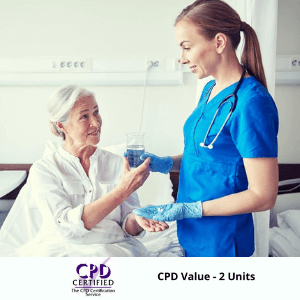Introduction to the Safe Handling of Medicines
The course begins by introducing key medicinal terminology, and giving an overview of the different roles of people involved in the administering of medicines. In a care home setting the chain between the diagnosis of a condition and the administering of a drug generally follows the pattern:
- The prescriber. This is usually a GP, who is responsible for the diagnosis
- The dispenser. This is the pharmacist who dispenses the prescription given by the prescriber
- The service manager. In care home situations, the care home managers ensures that policies and guidance around medication is followed, including ensuring that individuals handling medicines are competent
- The care worker who administers the drug. This individual ensures medicines are handled safety and in line with the care home procedures
Who is this course for?
This introduction to safe handling of medicines is primarily intended non-medical personnel who administer medicines to service users. This can be in the context of care homes, private homes or other settings.
Standards and Regulations
Before a medicine can be used in the UK, it must be granted a licence. This licence indicates the medication reaches a minimum safety standard set down by the regulatory agency – the Medicines and Healthcare Products Regulatory Agency (MHRA).
Prescribed medication is tightly controlled by legislation. We examine some of the primary controls and legislation that relate to medication in the UK, which fall into two categories:
- Direct legislation. This includes the Medicines Act and the Misuse of Drugs Act.
- Indirect legislation, which includes the Health and Social Care Act and the Health and Safety at Work Act.
Administering Drugs
We look at the various ways in which drugs are administered to patients. Broadly these groups fall into three categories for the purposes of the level of control
- The first group must be administered by a qualified nurse. An example of this is intravenous drugs that requires injection into a vein
- The second group can be administered by a carer, after training and under supervision. Examples are aural medication, administered into the ear.
- The third group can be administered by a carer or other competent person who has undertaken this course within the last 12 months. An example is oral medication – administering into the mouth.
The course gives basic hygiene rules concerning the handling of medicines before and after administering them to patients. Washing hands properly and wearing disposable gloves are two of the best ways of reducing infection and you are taken through the correct clinical handwashing technique.
Documented Policy on Safe Handling of Medicines
Where there is a responsibility on the part of care workers to administer medicines to service users, there must be a documented policy on medicines. This policy must comply with relevant legislation and observe best practices. What is included in the policy document will depend on the individual responsibilities of the specific social care providers. Areas that are commonly covered are:
- Giving support to those who take medicine in co-operation with health professionals
- Sharing information about a patient’s medical record because of very specific reasons and with consent, if possible.
- Ensuring good record keeping of the administration and safe handling of medicines as a matter of course
- Safe storage and disposal of medicines
- Ensuring the competency of those who administer medicines
- management of concerns over medicines and medicine-related incidents on safeguarding
** The Department of Health, in conjunction with the University of Leeds, have produced this useful guide for the administration and safe handling of medicines in care homes.
| Course Content | Module |
| Introduction to the course | 1 |
| Terminology explained | 2 |
| The roles, legislation and licensing | 3 |
| Groups of medicines | 4 |
| Levels of support and routes of entry | 5 |
| Infection control and equipment | 6 |
| Label interpretation and the seven rights | 7 |
Introduction to the Safe Handling of Medicines

CPD Units ‘2’
Course Assessment
Online assessment in the safe handling of medicines training is carried out by a series of multiple choice questions. Candidates must answer 70% of the questions correctly to pass each module. We advise you to complete each module and answer the question before moving on to the next module. This provides a better learning experience because you will need to have knowledge from earlier modules to understand some of the material in the later modules. For those who complete the course successfully, a PDF certificate of the award is sent directly to your inbox. Hard copies of the award are available on request. The course takes 60 minutes of training to complete. This is course content only and does not cover the time it takes to answer questions.
Other Related courses to the Introduction of Safe Handling of Medicines in Social Care include
Handling Information in a Care Setting
Infection Control Training


